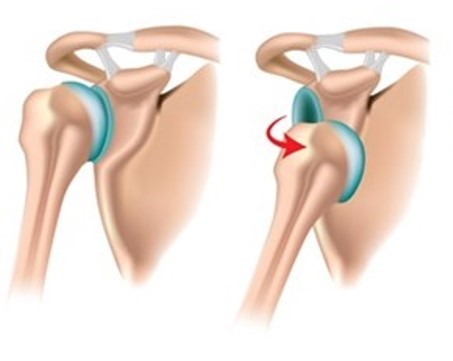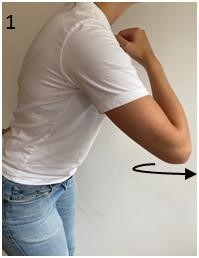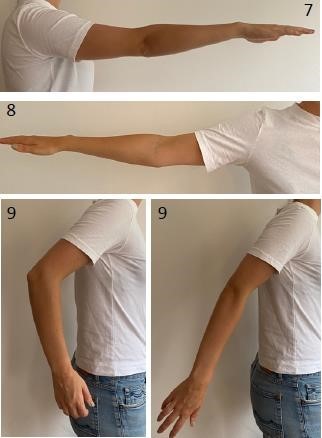Introduction
You dislocated your shoulder, with your upper arm shot forward out of the shoulder socket (anterior shoulder dislocation). The treatment consists of wearing a sling, having a short rest period and doing relevant shoulder exercises. To ensure a speedy recovery, we recommend that you contact a physiotherapist in the first week.
Overview- You dislocated your shoulder.
- This injury usually mends well.
- An outpatient check-up is generally not necessary, so there is no need to make a new appointment.
- You will be wearing a sling for the first week. After your visit to the hospital, you can start training your shoulder as much as your pain or physical complaints allow.
- Please find an instructional video for reapplying the sling in the Virtual Fracture Care app in the leaflet.
- It is important that you start the exercises mentioned in this leaflet as soon as possible. This prevents the shoulder and other joints from becoming stiff.
- Appropriate exercises can be found in this leaflet or in the Virtual Fracture Care app.
- By training your muscles you reduce the chance that the shoulder will dislocate again.
- We advise you to always contact a physiotherapist to help you recover. In men over 35 in particular, this really contributes to preventing the shoulder from dislocating again.
- If you have any questions or problems during the recovery, do not hesitate to contact us on “breuklijn” (fracture hotline): (0314) 32 92 50 on work days between 10:00 - 12:00. This Hot Line is easily accessible in case your pain does not subside.
- Is the pain getting worse, has the pain/stiffness not reduced after 2 weeks, or are you behind in the exercise schedule? Please contact the Fracture Hot Line. If a check-up seems necessary, we will schedule an appointment. The Hot Line is easily accessible, so please use it to prevent any issues in the long run.
|
The treatmentA dislocated shoulder, with the upper arm shot forward out of the socket, is something we see quite often. When the shoulder is back in place after repositioning it, the pain often eases immediately. The treatment consists of wearing a sling, having a short period of rest and doing specific shoulder exercises. By training your muscles you reduce the chance that the shoulder will dislocate again. This also reduces the risk of pain and stiffness in the shoulder.

There are several tendons and muscles around the shoulder joint that keep the shoulder stable. Once the shoulder has been dislocated, in some cases these tendons and muscles can become damaged. This can cause long-term pain or other physical complaints. The risk of this damage increases with age (50+).
It is important that you contact the Fracture Hot Line if your complaints (pain and/or stiffness) do not improve after 2 weeks, or if you are behind in your exercises. You can use the exercises at the bottom of this leaflet as a guideline for what you should be able to do and when. Please contact us for any question you may have in order to avoid problems with your recovery.
First week
|
- If you can, use the sling for support
- Train your shoulder as much as your pain or physical complaints allow.
|
Week 1-6
|
- Stop wearing the sling
- Train your shoulder as much as your pain or physical complaints allow.
|
Week 6 onwards
|
- Use your shoulder as you were used to before your injury, depending on the complaints
- Keep repeating the exercises until your shoulder functions normally again
- You can resume sports or gymnastics. It can take up to 3 months before all physical complaints are gone.
|
InstructionsThe following instructions are important to allow for a good healing:
- Have you received a sling? Use it for the first week to give the shoulder a rest. When you go to sleep you can take off the sling.
- Please find instructions for reapplying the sling in the Virtual Fracture Care app. (hyperlink video, in app version)
- You can immediately start exercising as much as your pain or physical complaints allow. It is important that you start exercising in time to prevent shoulder stiffness.
- A physiotherapist can help you recover. We advise you to contact a physiotherapist within 1 week. Make sure that your physiotherapist has experience in treating dislocated shoulders. We recommend that you call in a physiotherapist - especially for men under the age of 35 - who will help prevent your shoulder from dislocating again.
- In the first 2 weeks, do not lift the arm forward, turn it outward, lift it to the side, or extend it backward. This prevents the shoulder from dislocating again. For example, you should avoid the movement of combing back your hair.
- Use your arm and shoulder depending on your physical complaints. This means you can use the arm and shoulder for as long as you can tolerate the pain.
- You can find the exercises and instructions in the Virtual Fracture Care app or in the leaflet.
- You are not allowed to play sports for the first 6 weeks. After that you can slowly start exercising, as far as your pain complaints allow. It can sometimes take up to 3 months before you can exercise without complaints.
- Do you have pain? Use paracetamol if needed. Do not wait to take paracetamol until you are in too much pain. Always take it throughout the day. You can take 2 tablets of 500 mg paracetamol up to 4 times a day at fixed times. If your complaints persist, please contact us via the Fracture Hot Line.
Recovery- Generally, a check-up at the outpatient clinic is not necessary. It may take up to 6 weeks before you can fully use the arm and shoulder again.
- Once the shoulder has been dislocated, it is more likely to dislocate it again. This is especially the case in young (male), active adults. It is therefore very important to properly exercise and train the shoulder. This strengthens the muscles and makes the shoulder more stable. Moreover, it reduces the chance that the shoulder will dislocate again.
- Is the pain getting worse, has the pain not subsided after 2 weeks, does the shoulder feel unstable or stiff, or are you behind in your exercising schedule? Please contact the Fracture Hot Line. If a check-up seems necessary, we will schedule an appointment.
Rehabilitation exercisesAfter your shoulder has been dislocated in a forward motion, you may experience shoulder stiffness and loss of strength. Below are some specific exercises you can do to prevent this as much as possible. You can also find them in the Virtual Fracture Care app. During the first week it is wise to wear the sling for support.
Important! Do not overstep your own physical limits while exercising. Pain can be a sign of overexertion. If you feel pain, stop exercising. You may feel fatigue or muscle aches.
Do not proceed to the next step in the exercises until you are able to perform the previous exercises. Keep repeating the exercises from the previous weeks.
We advise you to go to a physiotherapist during your recovery, to guide you through the exercises.
When do I do which exercise?Week 1
- Train your shoulder as much as your pain allows. If you want, use the sling for support.
- Move the fingers and hand by making a fist 10 to 15 times a day.
- Straighten and bend your elbow 10 to 15 times a day.
- Press your forearm against your stomach. Hold this position for a few seconds and let go.
- Press your forearm against the side of your chest. Make sure your forearm is against your stomach. Hold this position for a few seconds and let go.
- Bend over slightly and make small circular motions with your elbow (pendulum movement)(1).
- Repeat 10-15 times in a row, 3 to 4 times a day.
|  |
Week 2
- You may take off the sling if the pain allows it. Try to keep it off as much as possible from now on.
Press your stretched forearm against the side of your body. Hold this position for a few seconds and let go (2). - Bend over slightly and let your arm hang down, stretched. Make small circular motions, clockwise and counter-clockwise (3).
- Bend and stretch the elbow while bent forward (4).
- Repeat 10-15 times in a row, 3 to 4 times a day.
- In the first 2 weeks, do not lift the arm forward, turn it outward, lift it to the side, or extend it backward. This prevents the shoulder from dislocating again. For example, you should avoid the movement of combing back your hair.
|   |
Week 3
- Move your hand over your chest towards your healthy shoulder and try to tap the shoulder blade. Support your elbow with your other hand (5).
- Place your hands against each other in front of your chest and press them together. You will feel the muscles at the front of your shoulder working (6).
- Stretch your arm. Bring it forward and lift it to shoulder height (7). Try to hold the arm here for a moment.
- Lift your stretched arm sideways up to shoulder height. If necessary, use a wall for some support (8) Try to hold the arm here for a moment.
- Move your arm backwards slowly with a stretched or bent elbow (9) .
- Alternate the exercises. Repeat 10-15 times in a row, 3 to 4 times a day.
|   |
Week 4-6- Repeat the exercises from week 3-4, now gently lifting the arm above shoulder level. You may move your arm as far as the pain allows.
Try to do exercises 7 and 8 while giving some counter pressure with the healthy arm, so against resistance. Train your shoulder as much as your pain allows. - Alternate the exercises and perform them at a leisurely pace. Repeat 10-15 times in a row, 3 to 4 times a day.
Week 6 onwards- Continue the exercises from the 5th week until you feel that the shoulder can do the same as before the shoulder dislocated.
- Swimming is a good exercise to get the shoulder function back to normal.
- Continuing to strengthen the muscles around the shoulder through exercise and sports reduces the risk of dislocating the shoulder again.
Questions?You can call us
If there are any questions after reading the information, please contact us or visit www.slingeland.nl.
Contact
Breuklijn, (0314) 32 92 50. Please call us on work days between 10:00 - 12:00. |
Virtual Fracture Care app Find more information about your injury in our app. The app also includes exercises that promote your recovery. You can find the app in the App Store (iPhone) or Google Store (Android).
You can also scan the QR code. You will then automatically be redirected to the app.










